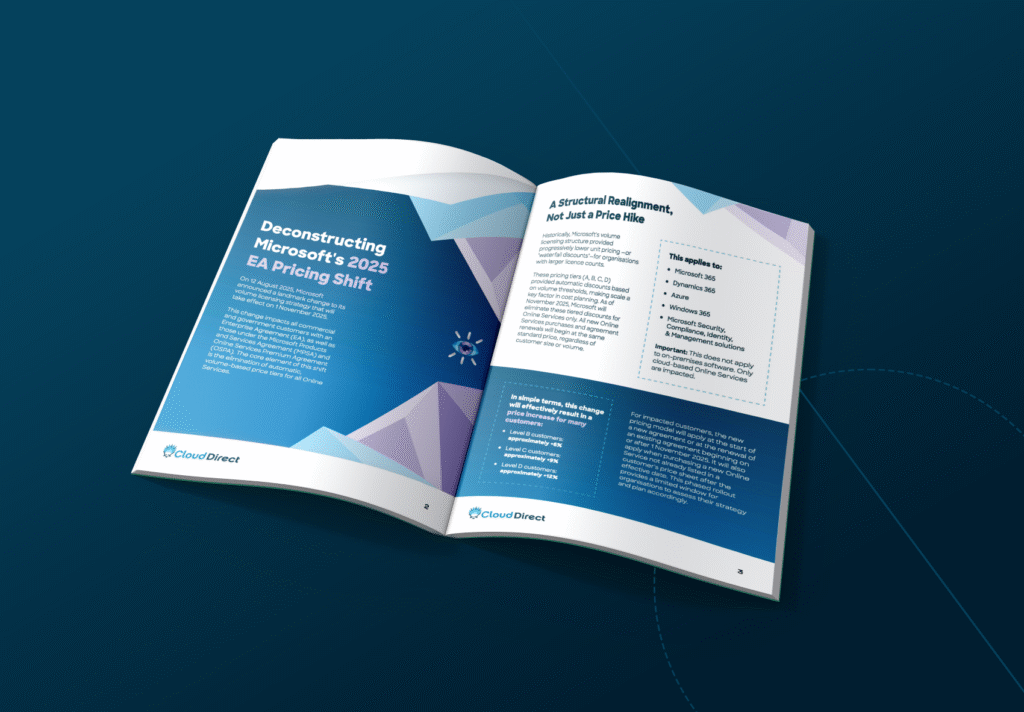
Cloud Direct’s Data & AI Practice Lead Dan Knott explains how you can strike a workable balance between speed of delivery, cost, and effectiveness with Microsoft Fabric.
I spend a lot of my time talking to executives and technologists. I understand the time and cost constraints; I understand the pressure to implement fast; I understand that many don’t have the appetite for lengthy assessments and strategising. But I also know that without some consideration of four key factors outside of, but directly impacting, Microsoft Fabric you’ll probably fail.
But first, a quick reminder.
Microsoft Fabric in a nutshell
You probably already know of Microsoft Fabric. It is a one-stop shop for data: a unified data platform that can ingest, process, analyse, and visualise your data. It centralises data storage in OneLake – a single, integrated data lake that supports structured, semi-structured, and unstructured data – and combines capabilities from Power BI, Azure Synapse, and Data Factory into a seamless experience.
Since its November 2023 launch into General Availability, Microsoft has continued to add functionality and, if you’re not already, you should now be looking at it.
Is Fabric a quick win?
Many in IT are going to look at this as a relatively easy implementation. But is it a quick win?
In one sense, yes. Fairly quickly, you can get to the point where it’s installed, providing some nice dashboards, and offering an incremental improvement over Power BI.
But in terms of delivering genuine business value, it won’t.
You’re going to hit obstacles. I know this because those that have gone before you are consistently telling me: “we tried to implement Fabric”, “we hit some bottlenecks”, and “the adoption wasn’t quite there”.
Navigating the pitfalls and driving real value from Fabric
While Fabric will happily ingest data from anywhere, it won’t fix fundamental data issues and it relies on users asking the right questions.
So, consider how the business is going to benefit from Fabric. There are valid analytical, AI, and machine learning use cases. If your use case is analytical, for example, and your interest is in sales, are you looking forwards or backwards? If you’re looking back, what lessons are you trying to take from this? If your focus is the future, how does this need to align with your growth or business strategy?
Regardless of your objectives, if people don’t trust the data then they’ll soon stop using Fabric. This, in itself, raises questions around the data, like its reliability and accuracy (realistically some areas will be better than others), who owns it, and security and governance considerations around who can access what.
Given the chance, I’ll always argue passionately for a strategic consideration of what I call your four key pillars: innovation, platform and technology, process and tools, and people and culture. It’ll help you to understand where you currently have gaps, where you can reliably use Fabric now, any priority areas for action, and enable you to make longer term plans. In short, it’ll enable you to ensure that your organisation can derive real business value from Fabric straight away.
Reality bites
Set against this, there are time and budget pressures: “we need to get this in”, “let’s do it and find out”, “what’s the worst that could happen?”
But from what I’m seeing and hearing, without a bit of thought and planning your implementation won’t get much beyond a tick in the box.
The adoption of Fabric is far wider than just putting the tech in, and if you’re familiar with project management’s ‘Iron Triangle’ you’ll know that when it comes to cheap, fast and good, and can only have two of them.
Striking the right balance
With a little planning and thought, a lot of the pitfalls can be managed and, to an extent, avoided.
Your journey probably won’t be the same as everybody else’s, but if we think in terms of the four pillars I mentioned, you’ll already know that there are some gaps.
What do you want to gain from your data? It needs to be grounded in purpose.
Are there data quality issues? Who’s accountable for this data? Are there governance considerations, perhaps around compliance and who can see which data? Do users have the skills to use the data well?
This will quickly tell you if ‘just do it’ feels rash or even scary, and whether or not you’re setting up Fabric to ultimately fail.
So, why not incorporate a bit of planning up front? Make sure that we’ve got the whole picture and have given some thought to those other areas which will impact the wider implementation of Fabric.
There’s often a lot of value to be gained from a thorough Data Strategy Assessment, but much depends on where you already are and, of course, time and budget pressures. This is where one of our Maturity Assessments will help you quickly create solid foundations for your Fabric implementation.
Microsoft Fabric really can show the value, purpose, and reliability of your data – but please, please, please put a little time into ensuring that your project can deliver business value, and ultimately succeed, before you get started.
If you’d like an informal chat about how you can best approach your use of Fabric, you can get in touch, using the form below.




